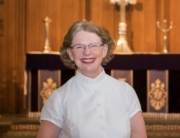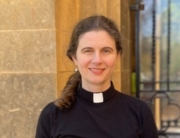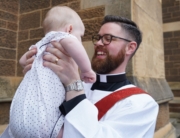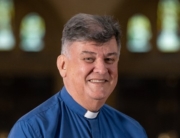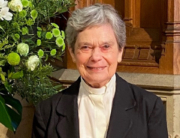A sermon given at 8am Holy Communion (BCP) by The Rev’d Canon Bill Goodes, on the 14th August 2022, the Feast of Mary, Mother of our Lord
The Order of the Administration of the Lord’s Supper or Holy Communion
I’d like to spend a little time with you on this Feast of Mary, Mother of the Lord, in reflecting on the order of service we use at 8 am. The latest booklet, the yellow one dated 2022 is now much nearer to the order contained in the BCP than was the one we used for some years, dated 2018.
The Book of Common Prayer was issued under the authority of the Crown in 1662, after the restoration of the monarchy in England. It was annexed to an Act of Parliament known as “The Act of Uniformity of common prayer…” . The 1662 book was a revision of earlier books, the one from Elizabeth I’s reign issued in 1559, which was in turn based on the second Book of Edward VI’s reign in 1552. The first English Prayer Book was issued earlier in Edward’s reign in 1549, and the 1552 book was a substantial revision of that. The language and theology of the services in these books all reflect the language and theology of the time — and the substantial differences between the 1549 book and the 1552 one were due to a change in which of the conflicting schools of theological thought had more power at the beginning and the end of Edward’s reign!
These changes were most marked in the Holy Communion rite. In 1549 the re-writing of the Latin Mass in the English of the time was reasonably conservative, and its structure followed that of the Latin service. So, after the ministry of the Word, bread and wine were brought to the altar, and a long prayer followed which began with the “Lift up your hearts” dialogue, followed by a substantial prayer of intercession. This led directly into a section remembering God’s work in history, including his words and actions at the Last Supper, then a section speaking of our offering and praying for the benefits of Communion. The Lord’s Prayer followed, the bread was broken, and communion was shared after a confession of sins, comfortable words, and a prayer of approach. A prayer of thanksgiving for communion came after the sharing of Communion, while the Gloria had been sung at the beginning of the service.
In 1552, this large prayer was divided into sections and separated from one another: the Prayer for the whole state of Christ’s Church, the dialogue leading to the “Holy, holy, holy” hymn, the remembering of God’s work including the repeating of Jesus’ words and actions at the Last Supper, followed immediately by the sharing of Communion, with the Our Father added to the prayer of thanksgiving after Communion. The Communion devotions, (confession, comfortable words, prayer of approach) were interspersed between the sections of the old thanksgiving. It was this structure that has been carried over into the 1662 version that we are using today.
How did this change come into being? What were the revisers trying to achieve?
It seems most likely that, in New Testament times, when the Church met to “break bread” (which is how they named what we do in Holy Communion), the presiding person would take bread and wine, offer a prayer which thanked God for his gracious actions, would break bread ready for sharing, and then the people would commune. This pattern followed Jesus’ actions at the Last Supper, and also the pattern of his feeding of the 5000 as John 6 describes it — taking, blessing, breaking, giving. The fact that the New Testament does not contain any specific form of Thanksgiving Prayer suggests that it was most likely made up by the presiding person, either new every time, or in some established pattern, which varied substantially from one presider to another. One of the earliest written forms of such a prayer is attributed to one Hippolytus who lived in the 3rd century, and it follows this pattern.
As time went on, the Church tried to put a bit more order into things, and authorised thanksgiving prayers came to be used in different areas. They followed similar patterns, but varied from place to place. It was only natural, then, that people using one form might look at another form and say, “That’s really not doing the job of setting apart the bread and wine as Christ’s body and blood!” Can you imagine that happening in a church?
What was it that was essential to ensure that the prayer really accomplished what was intended? The definition became narrower and narrower, until in the middle ages, the act which consecrated the bread and wine became limited, in people’s understanding, to the words Jesus spoke at the Last Supper in taking the bread and wine.
It was this understanding, universally held, that was current when the English Prayer books were compiled. This leads to the direction in 1662 that if the bread and wine consecrated are insufficient to give to all communicants, then more is to be consecrated, using only the appropriate words of institution.
The reformers, whose influence became stronger during Edward’s reign, between 1549 and 1552, hated the idea that the Mass was in any way to be seen as a sacrifice — something offered to God. The Thanksgiving was only to be seen as consecrating the elements for Communion. So the 1552 pattern, followed in 1559 and 1662 was that as soon as the words of Institution had been recited (along with the taking and breaking of the bread, the taking of the wine), Holy Communion was to be administered without delay — no stray prayers, hymns or other things were to get in the way! One of the radical innovations in 1662 was to insert an “Amen” between the words of institution and the communion!
Since 1662, all the Anglican revisions of the eucharistic Liturgy, both informally in the way the 1662 rite has commonly been celebrated, and in the preparation of modern, authorised service forms — these revisions have tried to move closer to the older form, with a more complex Eucharistic prayer, and more emphasis on separating the actions of taking, blessing, breaking and giving.
I hope that being reminded about some part of where our service fits in both language and theology, enables us better to participate in it with the heart and the understanding.

